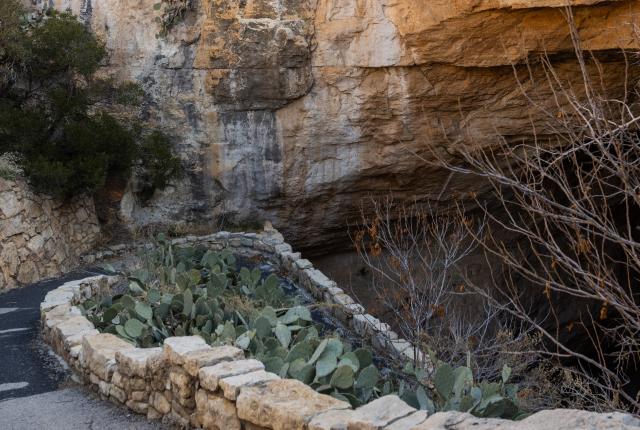AN APACHE STORY TELLS OF A MEDICINE MAN who ventured into the caverns and was never seen again. Every year, tribal members would visit the cave around the anniversary of his disappearance and leave food for him at the entrance. In 1903, when Texas cowboy Jim White first explored the cave’s depths, he found a skeleton.
“It was fairly deep, beyond where you would think a person could get easily,” says Rodney Horrocks, chief of natural and cultural resources for Carlsbad Caverns. “It’s kind of a mystery.”
Regrettably, people collected the bones in the 1920s, before anyone could determine whether they could be tied to this Apache legend. (Some now question whether they existed at all.)
The Mescalero Apache spent time in the Guadalupe Mountains from the 1400s to the late 1800s, their last place of retreat while the U.S. Army tried to capture and force them onto a reservation. Yet their inhabitance marks some of the more recent human history in the park. Evidence of humans dates back at least 10,000 years to Clovis scrapers and projectile points from when grasslands and palm trees carpeted this region. Megafauna like mammoths, mastodons, giant short-faced bears, camels, llamas, musk ox, and peccaries roamed the area until it started becoming more arid about 7,500 years ago. By 4,500 years ago, it closely resembled the current desert conditions, but threaded with streams and springs.
Read more: Make the most of your time in and around Carlsbad.
Hikers headed into the cavern’s natural entrance pass red-and-black pictographs painted on the wall, perhaps up to 4,000 years ago, as well as a mescal-roasting pit. For thousands of years, Native Americans have been cutting up agave plants and burying them in mounds of circular rocks, then covering the plants with rocks and a fire. Once dried, the succulent could be stored and eaten throughout the year.
Exactly who left the rock art isn’t clear, although Basketmaker and Apache peoples were known to have left rock art throughout the park. Puebloans, including those Ysleta del Sur, near El Paso, and Zia, near Bernalillo, were also known to visit the caverns and consider the cave a sacred site.
Horrocks points to a deep-cave rock-art site, only a handful of which exist in the country, as one of the more fascinating places in the park. About 500 feet into Slaughter Canyon Cave, two pictograph panels—yellow, red, and black symbols and a handprint outline—loom on the rock wall over a small pool that’s thought to have provided a reliable water source long ago. Deep into territory where a torch would have been necessary, those venturers also left pottery vessels, including one that’s intact and on display at the Carlsbad Museum. Although their meanings are unknown, one archaeological assessment dated them as more than 3,500 years old. Park officials asked, Horrocks says, and the Apache people told them these marks were made by their medicine men—symbols meant for only them to understand.
SHEEP-ISH
A North African native, Barbary sheep, or aoudad—sand-colored with crescent-shaped horns and shaggy fur hanging off their chests and front legs—are often spotted around the park’s entrance road (around dawn and dusk). Imported to a New Mexico ranch in 1941, they were released, or escaped, into the wild in the 1950s and ’60s. Often confused for native bighorn sheep, they’re very much at home in the Guadalupe Mountains’ sunny escarpments, enjoying life on steep, open slopes and rock ledges. But research is underway to see how they’ve affected native species.




